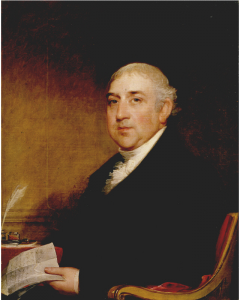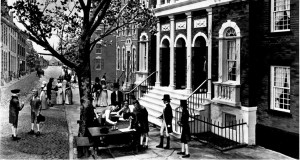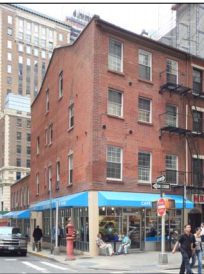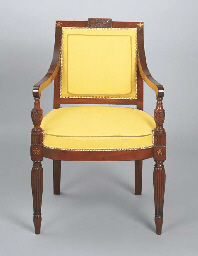Augustine Hicks Lawrence
Augustine Hicks Lawrence (1769-1828), the son of Augustine Lawrence (1719-1794) and of Joanna Annajte van Zandt (1729-1809). He is my wife’s fifth cousin, five times removed. He married Catherine Abramse Luquer (many variant spellings) (1729-1809). They had many, many children and numerous descendants.
The picture above, painted by Gilbert Stuart, was given to the New York Historical Society by his granddaughter, Eloise Lawrence Breese Norrie.
Like many of the Lawrence clan, he was involved in the finances of New York. He was the youngest founder of the New York Stock Exchange, which met under the Buttonwood tree on Wall Street.
The Buttonwood Agreement, which took place on May 17, 1792, started the New York Stock & Exchange Board now called the New York Stock Exchange. This agreement was signed by 24 stockbrokers outside of 68 Wall Street New York under a buttonwood tree. The organization drafted its constitution on March 8, 1817, and named itself the “New York Stock & Exchange Board”.
We the Subscribers, Brokers for the Purchase and Sale of the Public Stock, do hereby solemnly promise and pledge ourselves to each other, that we will not buy or sell from this day for any person whatsoever, any kind of Public Stock, at a less rate than one quarter percent Commission on the Specie value of and that we will give preference to each other in our Negotiations. In Testimony whereof we have set our hands this 17th day of May at New York, 1792.
Augustine was prominent in business and government.
A stock and insurance broker, banker, and commission merchant, he was in business by 1790 and was a partner in the firms of [Francis] Lewis & Lawrence ; Augustine H. Lawrence & Co. ; and Augustine H. Lawrence & Augustine N. Lawrence, with his son. By 1795, his firm was located at 40 Wall Street, and Lawrence had European business ties in London, Paris, and Amsterdam. According to Walter Barrett in The Old Merchants of New York, Lawrence was a close friend of DeWitt Clinton, Mayor of New York in 1803-07/1808-10/1811-15, who called him “The Chancellor of the Exchequer,” for “his financial abilities as the manager of the city funds and chairman of the finance committee, [and] alderman of the third ward.” The latter refers to his service as assistant alderman in 1809-13 and as alderman in 1814-16. He also was a director of the New-York Insurance Co., Bank of America, Farmers’ Fire Insurance & Loan Co., Globe Insurance Co., and other companies. In 1801, the Lawrence family moved to 23 Robinson Street. According to the 1810 census, the family owned two slaves at that time . Exemplifying his wealth and social status, Lawrence’s portrait was painted by the eminent artist Gilbert Stuart.
It is fitting that Augustine has left his mark on the physical structure of the city. In 2009 his house was designated an historical landmark:
94 Greenwich Street, New York
Around the corner is an extraordinary triplet of Georgian row houses, 94-96 Greenwich Street, built by Augustine H. Lawrence in 1798-99. The very existence of a cohesive 18th-century group is astonishing enough, but the corner house — once home to a merchant and alderman named Jonathan Lawrence — is also in remarkably good condition above the loud storefronts on the first floor. Nine windows overlooking Rector Street have elegant splayed lintels with double keystones. Above them, the outline of the original steeply pitched roof can be discerned.
What makes this house highly significant is that it is among only five surviving houses of Manhattan’s most elite neighborhood of the post-Revolutionary War era, the others including the Watson House (1793, 1806), 7 State Street, and Dickey House (1809-10), 67 Greenwich Street, both designated New York City Landmarks. No. 94 Greenwich Street is among the relatively rare extant Manhattan houses of the Federal period and style, is one of the oldest houses in Manhattan, and is one of only seven pre-1810 houses located south of Chambers Street, the oldest section of New York City.
Its history has been reconstructed:
The Federal style rowhouse at No. 94 Greenwich Street in Lower Manhattan was constructed c.1799-1800 as an investment property, right after this block was created through landfill and Greenwich and Rector Streets had been laid out. At the time, this was the most fashionable neighborhood for New York’s social elite and wealthy merchant class. The owner of No. 94 was Augustine Hicks Lawrence, a prominent stock and insurance broker, banker, and commission merchant, who served as director of a number of banks and companies, as well as an assistant alderman and alderman in 1809-16. What makes this house highly significant is that it is among only five surviving houses of Manhattan’s most elite neighborhood of the post-Revolutionary War era, the others including the Watson House , 7 State Street, and Dickey House , 67 Greenwich Street, both designated New York City Landmarks. No. 94 Greenwich Street is among the relatively rare extant Manhattan houses of the Federal period and style, is one of the oldest houses in Manhattan, and is one of only seven pre-1810 houses located south of Chambers Street, the oldest section of New York City.
As constructed, the house was three-and-a-half stories with a high peaked gambrel roof – the outline of the original roofline is still visible on the Rector Street facade. It features Flemish bond brickwork and splayed lintels on the second and third stories, those on the Rector Street facade are marble with double keystones, while the Greenwich Street facade has splayed brick lintels. By 1810, No. 94 had become a boardinghouse for merchants and professional men , housed a porterhouse by 1837, and was listed as a hotel in 1841. The building was raised one full story prior to 1858, and has a two-story rear addition dating from c. 1853/1873. The building remained in the possession of Lawrence family descendants until 1921, and has housed a variety of commercial tenants. Despite alterations, the 94 Greenwich Street House is recognizable as a grand early Federal style rowhouse, made particularly notable by its height, corner location with two primary facades, the visible outline of the original gambrel roofline on the Rector Street facade, and its splayed marble lintels with double keystones .
Beginning in 1810, today’s Nos. 94 and 94-1/2 Greenwich Street were combined internally and operated as an elite boardinghouse primarily for merchants and professional men.At the death of Augustine H. Lawrence in 1828, his three houses at Nos. 94, 94-1/2, and 96 Greenwich Street, among his most valuable assets, were bequeathed to his three married daughters, and to their future heirs: No. 16 Rector was left to Joanna Lawrence McCrea; No. 94 Greenwich to Sarah Middagh Lawrence Benson; and No. 96 Greenwich to Eliza Lawrence Mactier; his son and business partner, Augustine Nicholas Lawrence, inherited the Stuart portrait of his father.
1850-51, No. 94 Greenwich was the Union Hotel, under the proprietorship of J[ean]. Baptiste Pelissier & Co.
Between 1860 and 1888, Nos. 94 and 94-1/2 Greenwich Street were jointly leased and occupied by the extended families of the Irish-born James and Thomas Cherry, presumably brothers. City directories listed James Cherry at No. 94 as a liquor dealer between 1860 and 1884, but an 1870 commercial directory listed the address as No. 94-1/2; Capt. Thomas Cherry was a policeman. The censuses of 1860, 1870, and 1880 indicated that between eight and eleven families lived in the two buildings. From 1862 to 1872, Otto Hemken operated a drugstore at 94 Greenwich Street, definitely this building as it was located on the corner; and Charles Wilson, oyster saloon/eatinghouse, was listed at that address in 1864-66. A shoe store was located in No. 14-16 Rector Street between c. 1868 and 1883, under Lewis Wenith , Patrick Casey , and John Kirwan . In 1873, James Cherry added a second story to the building’s Rector Street wing. From 1885 to 1921, Michael L. Shannon, liquor dealer , was listed at No. 94 Greenwich Street.
A tenant, the Pussycat Lounge, occupied one of Augustine’s buildings and campaigned for its historical designation:
The proprietor of a topless bar is attempting to prevent a hotel developer from developing his space two and a half blocks south of ground zero by invoking the Landmarks Preservation Law.
Robert Kremer, who holds the lease on the Pussycat Lounge, spoke in favor of landmark designation of one of Manhattan’s oldest houses at a public hearing yesterday at the Landmarks Preservation Commission.
Preservationists say 96 Greenwich Street House, along with the adjacent 94 and 94 1/2 Greenwich St. buildings, are rare examples of a row of Federal-style houses, offering a glimpse of early New York. The area south of ground zero has suffered from being blocked off from the rest of the city by the 16-acre void left at the site of the former World Trade Center. Recently, developer Joseph Moinian has begun work on a 53-story hotel and condominium nearby. Much of the financial district has seen conversion to residential from office space in the past few years as the nature of downtown has changed toward a more full-time environment.
The Pussycat Lounge, long a neighborhood watering hole for Wall Street brokers and civil servants, sits on an eclectic block that also has a boxing gym and delis. A long bar runs most of the length of the Pussycat Lounge, behind which is a stage where scantily clad women perform. A small knight and a cat are design props upon the stage. The second floor is a rock ‘n’ roll club.
The executive director of the Greenwich Village Society for Historic Preservation, Andrew Berman, said these structures, built when John Adams was president, were among the few surviving relics of the first era of development in New York.
At the hearing, architect Gene Kaufman, whose client is Greenwich Hospitality LLC, an affiliate of developer Sam Chang, said that because relatively little of the fabric and design of the original building at 96 Greenwich St. remain, the building did not merit designation.
Simeon Bankoff, who said he was speaking on his own behalf and not in his capacity as executive director of the Historic Districts Council, said that regardless of the alterations, the 18th-century building’s significance was not diminished. He said, metaphorically, “You don’t throw out your grandma just because she has new teeth.”
The president of the Real Estate Board of New York, Steve Spinola, had not examined these buildings on Greenwich Street, but told The New York Sun that there was a great deal of interest in building hotels in Lower Manhattan. “There’s a clear understanding that there’s not enough hotel room downtown,” Mr. Spinola said. He added that business is thriving downtown, and the residential side of real estate has grown there. He said that when the memorial at ground zero is built, anticipated visitors to the area will number in the millions.
Those speaking on behalf of landmarking the buildings included a vice president of Doremus Financial Printing, Thomas Tyrrel, who praised them as “monuments to our past.” Lisa Kersavage of the Municipal Art Society quoted architectural critic Ada Louise Huxtable, saying these buildings were among “accidental and anonymous survivors” of the city’s early years.
Mr. Kremer, who said he has owned Pussycat Lounge since 1974, has filed suit in state Supreme Court, arguing that he has an ownership interest in 96 Greenwich St. An attorney for Greenwich Hospitality LLC, Robert Davis of Bryan Cave, said his client was the bona fide purchaser of the building.
Mr. Kremer said he was prepared to fully restore 96 Greenwich St., and that he still had the original doors from Ryan’s, the predecessor bar. Alternatively, assuming the LPC did not designate 96 Greenwich St., Mr. Kaufman said his client would restore the façade to the other two buildings to standards determined by the LPC. In that case, the building at 96 Greenwich St. would become part of the footprint of a hotel slated for 98-100 Greenwich St.
As an alderman, Augustine commissioned furniture for the new City Hall.
Construction of the grand edifice of City Hall was begun in 1803, and took nine years and almost half a million dollars to complete. When the exterior of the building was nearly complete, Alderman Nicholas Fish and assistants Peter Hawes and Augustine H. Lawrence were authorized “to procure Suitable furniture” for the chamber. The furnishings committee for the chamber rushed to complete the interior in time for the Independence Day celebrations planned for City Hall, and authorized payment of Lannuier’s April 25 invoice in July. He charged fourteen dollars each for the chairs, and appropriately embellished them with inlaid brass stars and tablets carved with ribbons and crossed flags, symbols of patriotism and government.
I suspect that the reasons for the importance of the Lawrences in the financial life of the city are
- They were there since the mid-seventeenth century.
- They were stable. They sometimes lived in the same house foe 250 years – an extraordinary and perhaps unique accomplishment in New York. One Lawrence, a governor of the New York Stock Exchange, not only lived in the ancestral house; he lived his whole life in the same room. He was born and died in the same bedroom. Such stability gave confidence that a Lawrence was not going to abscond to Brazil.
- They were Quakers for a long time. This gave them both connections and a reputation for integrity, which may have helped in both the financial and pharmaceutical world.
His descendants to this day are active in finance, for example, Dana Lawrence Woodbury.
Dana Lawrence Woodbury
Dana Woodbury, founder and President of Buttonwood Investment Services, LLC has been in the financial services industry since 1981. He has worked as a financial planner, due diligence consultant, and high yield bond portfolio manager. In January 1989, he began his association with a national independent broker/dealer, and during his twelve-year tenure served as Director of Due Diligence, Compliance Officer, and Senior Vice President of Equity Sales.Dana has been nationally recognized for his due diligence work, being named to the All Star Team of Due Diligence Officers by the Investment Advisor Magazine (1992, 1993, 1994). He has also served on the Financial Products Advisory Council for the International Association for Financial Planning (IAFP, now the Financial Planning Association or FPA), and has spoken at numerous national meetings on due diligence analysis and asset allocation. He has been quoted in the New York Times, Rocky Mountain News, and the Denver Business Journal.Dana now leads a team of experts in the due diligence field. Specializing in the analysis of illiquid investments, Buttonwood is known for generating a concise and prompt review of alternative products. Providing Financial Professionals with a sound knowledge of the program merits and presenting those to suitable clients is his top priority. Dana received his B.A. in Economics from Northwestern University and his M.B.A. from The University of Chicago.
Note that Dana is a specialist in due diligence, which means that he does a thorough and careful analysis of investments to avoid any unpleasant surprises. I detect a certain family preference for security and stability.
Buttonwood Investment Services, LLC takes its name from the buttonwood tree under which the agreement founding the New York Stock Exchange was signed. Dana Lawrence Woodbury’s great, great, great, great grandfather, Augustine Hicks Lawrence was the youngest founding member under that famous buttonwood tree.




